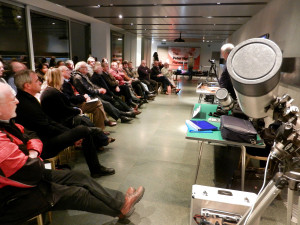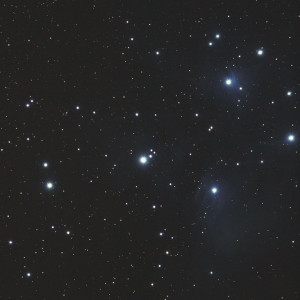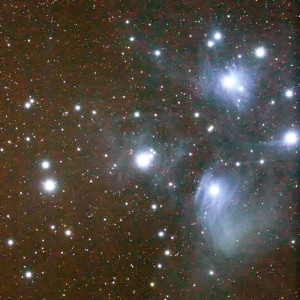February 26, 2013
Introduction to Astrophotography Workshop
Report by: Mike Meynell
It has been evident over the last few years, particularly in relation to the huge success of the Astronomy Photographer of the Year competition at the Royal Observatory Greenwich, that there is a great deal of interest in the subject of astrophotography. To try to satisfy some of this interest, the Flamsteed ran their first ever ‘Introduction to Astrophotography’ workshop. Demand for tickets was very high and the 40 tickets available for the event were snapped up by Flamsteed members very quickly.
Malcolm and I were the main presenters on the evening, ably assisted by Martin Male, who passed on his huge knowledge of photographing the wonderful dark skies over his observatory in Romney.
We first discussed the many different methods by which photographs of the night sky can be captured, from using basic camera phones through to high-end CCD cameras, via compact cameras, DSLRs and webcams. So, what is the minimum requirement for taking images of the night sky? At the very least, you should have a compact digital camera or camera phone and a tripod. A digital SLR camera gives you the most flexibility when taking images, with the added bonus that it can be used for purposes other than astrophotography. Webcams are a great option for planetary imaging, but need to be used in conjunction with a telescope, as do specialist astronomical CCD cameras.
So, here are some basic tips for taking images with a DSLR or compact camera, without using a telescope:
- Use a tripod
- Use manual focus – we had lots of discussion on methods for focussing. Setting the focus to ‘infinity’ is not quite accurate enough, particularly as most cameras have a range of focus options for infinity to cope with operating temperature conditions. Initially, you should focus on the brightest distant object you can see. Auto-focus doesn’t tend to work, though you may get away with it on a bright object like the Moon. One method is to use cameras with a ‘live-view’ option, which also allow you to zoom in on the live view to get a really sharp focus. Other methods use specialist focussing aids, like Bahtinov masks. I demonstrated a technique using camera control software, with the camera linked up to a laptop.
- Use a remote shutter release, or set the shutter delay to around 10 seconds, to minimise camera shake.
- Set the ISO to a high setting (e.g. ISO 800+, or higher if your camera can manage it). Be careful not to introduce too much noise in the resulting image by setting the ISO too high.
- Open the aperture of your lens to its widest setting (i.e. low f-number). This can produce images that are a little ‘soft’, depending on the quality of the lens that you are using, so it is sometimes necessary to ‘stop-down‘ the lens by one or two stops to compensate (e.g. on a f/2.8 lens, you could ‘stop-down’ to f/4 or f/5.6 to sharpen the image).
- Set your camera to ‘manual’ and adjust the exposure times.
- Store your images as ‘RAW‘ files, rather than JPEGs.
- Use foreground objects to add interest to an image.
It’s important to inspect your results and see if any adjustment is required to exposure time. Malcolm produced a very useful spreadsheet showing the recommended exposure times for objects, depending on where the object is in the sky and the focal length of your lens. By sticking to these exposure times, you will prevent ‘star trails’ appearing on your image, which become apparent as the Earth rotates:
Sometimes, however, you can use the effect of ‘star trails‘ to produce some very effective images using long-exposure photography or by stacking lots of short exposures of the same patch of sky. I demonstrated a method of creating an image with long star trails (see here for the resultant image), using software to stack a series of equal length exposures. There are lots of software packages available that allow you to do this, much of it free, some examples being StarStaX and Startrails.
We then moved on to using a telescope in conjunction with a camera. There are several techniques for using telescopes:
- ‘Afocal imaging’ uses the camera, with its lens, mounted over the eyepiece of the telescope. For very bright objects (e.g. The Moon) you may be able to hand hold the camera over the eyepiece but it is usually better to mount the camera using specialist equipment.
- DSLRs can be connected to a telescope using a ‘T-Ring’ and ‘T-Adapter’ for prime focus imaging. The camera lens is removed and the telescope is used like a telephoto lens. A T-Ring is a coupling ring to connect a 35mm camera to a T-adaptor which then connects to the telescope.
- Inexpensive webcams can be connected to a telescope to take videos containing hundreds or thousands of single frames. This form of imaging is ideal for lunar and planetary astrophotography. Video files can be processed in software (e.g. RegiStax) to select the best frames and stack and average the remaining images.
- Astronomical CCD cameras can be used, which have high resolution and low noise, but can be very expensive.
Finally, we looked at methods for processing images. Processing of astronomical images has rightly been termed the ‘black arts’! A huge number of resources are available both online and in printed format which try to explain the best way of processing images. The best advice we can give is to take lots of images and experiment. However, there are a few tips that can help:
- Wherever possible, use RAW format when taking your images, to give yourself the best range of processing options. RAW formats allow you to adjust white balance and other settings after the image has been taken.
- Several software packages are available to process images. Whereas some are very expensive, but very versatile (e.g. Photoshop), free software is also available (e.g. GIMP, Irfanview).
- Images can be stacked to effectively increase exposure time, adding more detail to the image and reducing noise. Software for stacking includes Deep Sky Stacker and RegiStax.
I demonstrated an interesting example of an image of the Pleiades which was taken in Romney. 10 x 2-minute exposures of the Pleiades were stacked using the software Nebulosity. The resulting image was then processed in Photoshop, and a number of ‘levels‘ and ‘curves‘ adjustments were made to bring out detail in the image.
The results were dramatic:
The workshop ended with a brief question and answer session and with Malcolm’s quote from a famous golfer “the more I practise, the luckier I get!”. How very true.
Pictures from the Evening (by Grey Lipley):
Posted under: Flamsteed, Meeting Report, Workshop














You must be logged in to post a comment.